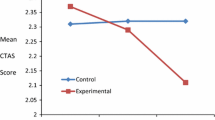Abstract
A cognitive therapy was administered in a group format to test-anxious college students. Subjects were randomly assigned to groups meeting for eight weekly sessions, groups meeting for four weekly sessions, or a waiting list control group. The overall pattern of results suggested that the eight-session condition was superior to the four-session condition, which was superior to the control condition in reducing self-reported test anxiety. On the other hand, neither a task performance measure nor grade point average showed any effect of treatment.
Similar content being viewed by others
References
Beck, A. T.Cognitive therapy and the emotional disorders. New York: International Universities Press, 1976.
Bruch, M. A Type of cognitive modeling, imitation of modeled tactics, and modification of test anxiety.Cognitive Therapy and Research 1978,2 147–164.
Chambliss, C. A., & Murray, E. J. Efficacy attribution, locus of control, and weight loss.Cognitive Therapy and Research 1979,3 349–353.
Finger, R., & Galassi, J. P. Effects of modifying cognitive versus emotionality responses in the treatment of anxiety.Journal of Consulting and Clinical Psychology 1977,45 280–287.
Goldfried, M. R. Cognitive behavior therapy for anxiety (Tape). In D. Meichenbaum (Ed.),Cognitive behavior therapy. New York: BMA Audio Cassettes, 1978.
Goldfried, M. R., Linehan, M. M., & Smith, J. L. Reduction of test anxiety through cognitive restructuring.Journal of Consulting and Clinical Psychology 1978,46 32–39.
Goldman, B. L., Domitor, P. J., & Murray, E. J. Effects of Zen meditation on anxiety reduction and perceptual functioning.Journal of Consulting and Clinical Psychology 1979,47 551–556.
Holroyd, K. Cognition and desensitization in the group treatment of test anxiety.Journal of Consulting and Clinical Psychology 1976,44 991–1001.
McCordick, S. M., Kaplan, R. M., Finn, M. E., & Smith, S. H. Cognitive behavior modification and modeling for test anxiety.Journal of Consulting and Clinical Psychology 1979,47 419–420.
Meichenbaum, D. H. Cognitive modification of test anxious college students.Journal of Consulting and Clinical Psychology 1972,39 370–390.
Parloff, M. B., Waskow, I. E., & Wolfe, B. E. Research on therapist variables in relation to process and outcome. In S. L. Garfield & A. E. Bergin (Eds.),Handbook of psychotherapy and behavior change (2nd ed.). New York: Wiley, 1978.
Spielberger, C. D., Gonzalez, H. P., Taylor, C. J., Algaze, B., & Anton, W. D. Examination stress and test anxiety. In C. D. Spielberger & I. G. Sarason (Eds.),Stress and anxiety (Vol. 5). New York: Hemisphere-Wiley, 1978.
Wesman Personnel Classification Test. New York: Psychological Corporation, 1967.
Wine, J. Test anxiety and direction of attention.Psychological Bulletin 1971,76 92–104.
Yalom, I. D.The theory and practice of group psychotherapy. New York: Basic Books, 1970.
Author information
Authors and Affiliations
Additional information
This article is based on a master's thesis by the senior author supervised by the junior author.
Rights and permissions
About this article
Cite this article
D'Alelio, W.A., Murray, E.J. Cognitive therapy for test anxiety. Cogn Ther Res 5, 299–307 (1981). https://doi.org/10.1007/BF01193413
Issue Date:
DOI: https://doi.org/10.1007/BF01193413




